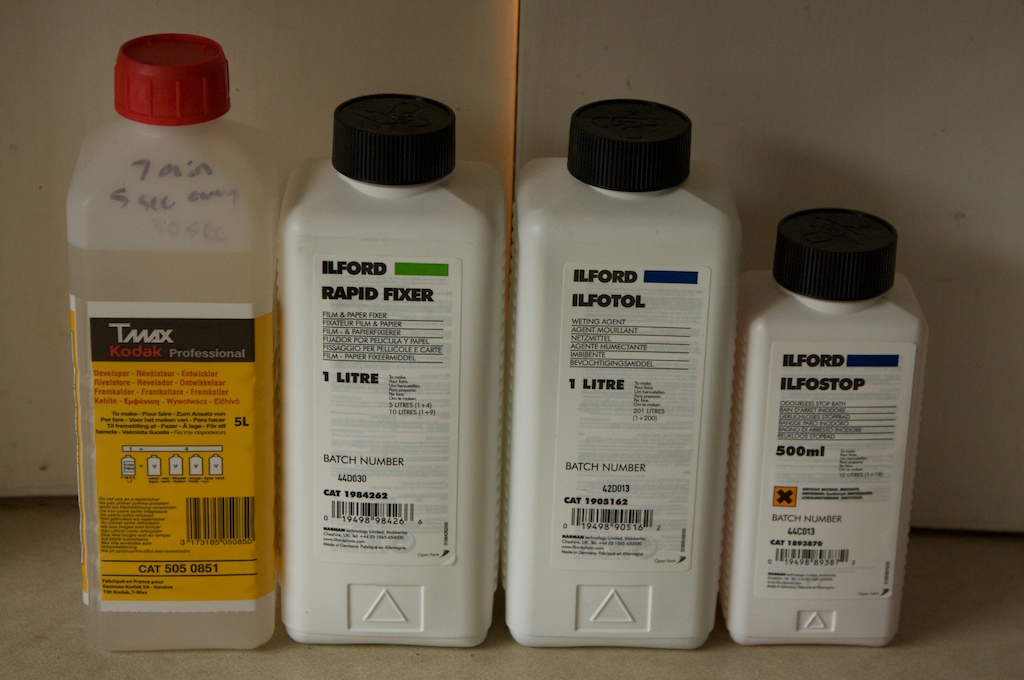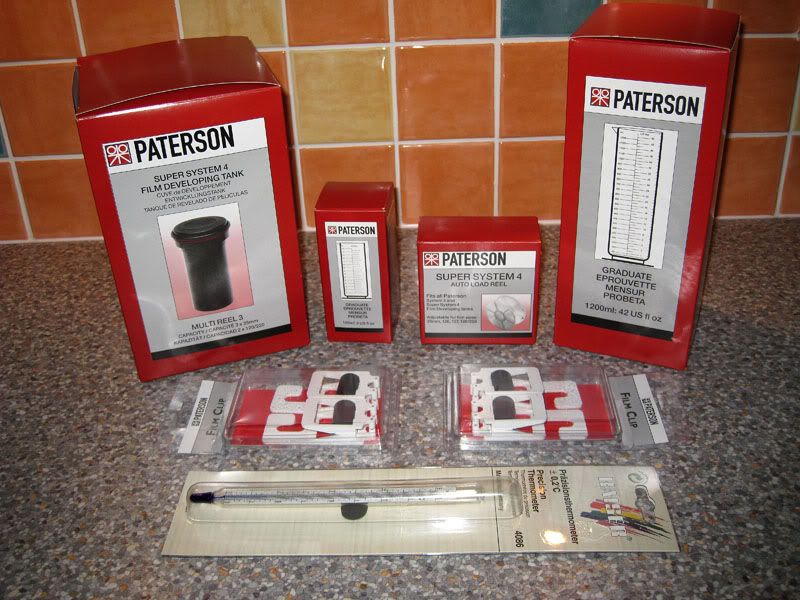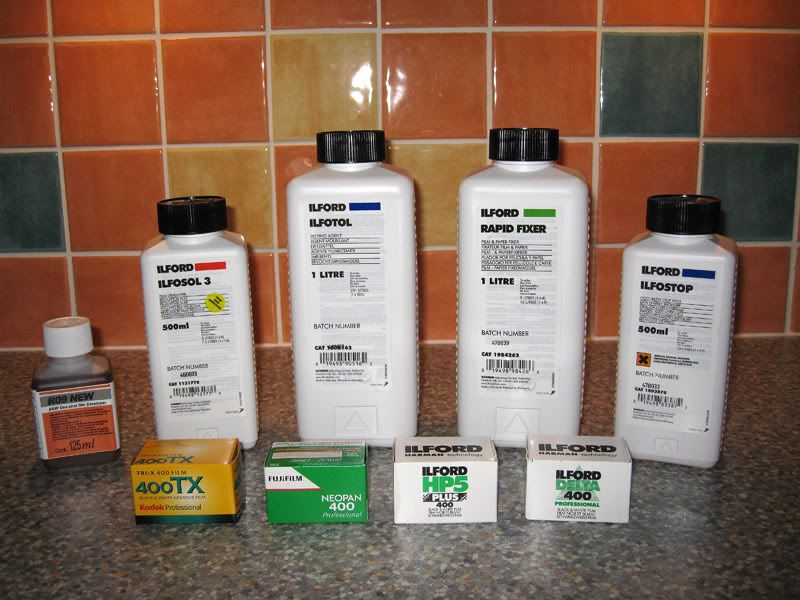Dear all,
here's an article off my website that might help with developing technique.
It talks about using Perceptol (another powder-based developer from Ilford) and HP5 plus.
I hope it's useful.
There's also a development chart in the techniques section of my site.
Producing Fine Negatives using Ilford HP5 plus and Perceptol.
Contents
Introduction
Exposure
Consistent Development Technique
Preparation
Processing the film
Introduction
The process of producing a fine print starts long before the photographer enters the darkroom. The most important step in this process is the production of a 'fine negative'. Essentially, this involves exposing the film to maximise the amount of detail in the shadows and using development to control the highlights.
The purpose of this page is to outline the process for producing fine negatives using Ilford HP5 plus developed in Ilford's Perceptol developer. If these guidelines are followed, then provided you have exposed your film correctly, fine negatives are virtually guaranteed.
Exposure.
Rate Ilford HP5 plus at EI200 - THIS IS VERY IMPORTANT!!!
Consistent development technique
Before we start to discuss the actual process of film development, it is important to stress the importance of consistency and control during development. As you become more experienced, you will probably want to conduct personal film speed tests and personal development time tests. By carrying out these tests you are able to exercise a very high degree of control over the final image. However, unless your developing technique is absolutely consistent then the tests will be a complete waste of time. The factors that affect consistency are:
* Temperature - this needs to be controlled to within half a degree Celsius - don't worry, this is not as difficult as it seems! It is important that all of the solutions and the water used for the pre-soak and film washing are at the same temperature.
* Time - You must stop your development timing at the same point for every film that you develop. If you decide to fill the tank and start timing rather than start timing and filling the tank, then stick to it. What other people do is immaterial - what matters is that you do the same thing every time!
* Agitation - Always agitate in the same way and using the same method. In his book 'Elements', Barry Thornton advocates inverting the tank and using a twisting motion to ensure that no eddies are set up in the tank. This method works very well indeed.
Preparation.
Before you start developing your film, you will need the following items:
* Four plastic jugs, one each for your pre-wash, developer, stop and fix baths
* A developing tray. This will be used as a tempering bath to maintain the temperature of the solutions
* A clean washing up bowl - for your water
* An accurate thermometer (preferably two - but they must give consistent readings!)
* Your pre-loaded developing tank
* Your stock solution of Perceptol (for details on how to make up the stock solution, instructions can be found on the inside of the cardboard packet that contains the developing powders.
Fill the washing-up bowl with water at 24 degrees Celsius. Ideally, the water should be filtered to remove any detritus from it. It is well worth obtaining a Paterson water filter - they are reasonably cheap and quite effective.
Make up the developer using 1 part of stock solution to two parts of water. For a single 35 mm film in Paterson developing tank,you will need 300 ml of developer, which is made up of 100 ml of stock solution and 200 ml of water.
Heat the developer, stop and fix to 24 degrees C in the tempering bath. I normally start with a fairly hot bath to speed things up and when things are at the correct temperature, cool it down to say 26 degrees.
When everything is up to temperature, you can start to developyour film.
Processing the film
The Pre-soak
Fill the developing tank with clean water from your washing-up bowl at 24 degrees C. Tap the tank on the bench to remove any air bubbles and leave it to stand for 1 minute.
Pour the pre-soak water down the sink. If you are developing a 120 film the water will have taken on a dark blue hue. Don't worry this is just the anti-halation layer and some dyes in the film.
If there is a major variation between the solution temperature and the air temperature, a second pre-soak should do no harm, but I have never really needed this.
Development
Pour the developer into the tank and start the timer. Put the lid on the tank and agitate by inverting the tank until 30 seconds have gone by.
Tap the tank on the bench to remove any air bells.
After one minute, agitate the tank for ten seconds (I normally find that four inversions is sufficient) and tap the tank on the bench.
Repeat this step every minute until the end of the development time.
After about 4 minutes, check the developer temperature. If it has dropped below 23 and a half degrees, it is worth warming it up.
Do this by pouring warm water over the lid of the tank. The heat will be transferred to the developer when you agitate. It may take a couple of minutes to bring things up to temperature.
After 12 minutes, pour the used developer away (I normally start pouring it out at 11 minutes and 50 seconds). Note that dilute Perceptol is a one-shot solution - DO NOT TRY TO REUSE IT!!
Stopping and fixing
Pour the stop bath in to the tank, replace the lid and agitate for a few seconds. After 1 minute pour the stop bath back into its jug for reuse.
Pour the fix into the tank, replace the lid and agitate for ten seconds every minute. Fix for four minutes and pour the fix back in to its jug for reuse.
Washing
Using the water in the bowl, which should be at or very near to 24 degrees Celsius, fill the tank, replace the lid and invert it five times and pour the water away. Refill the tank, invert ten times, and again with twenty and finally forty inversions.
Remove the film from the emptied tank (DO NOT TAKE IT OFF THE SPIRAL YET!!!) and place a couple of drops of Ilfotol or similar wetting agent into the tank and then fill the tank with water from the bowl.
Replace the film spiral and agitate it by 'swishing' it up and down. I recommend that you leave it in the wetting solution for at least a minute - minute and a half.
Drying
Whether you use a squeegee on your films is a matter of personal choice. I tend to squeegee 35 mm films, but not 120 films. A good squeegee is essential if you are going to avoid scratches. It is not worth buying second hand - I did once and regretted it. The Jobo squeegee is very good. The blades are made of a very soft rubber and I have had no problems with it...Yet.
You only need to pass the film through the squeegee once.
Hang the film up to dry in a well ventilated, dust free area and do not touch it until it is absolutely dry. After a few hours, you will have negatives that are a dream to print, have minimal grain and are nice and sharp.
©Mark Pope 2000











